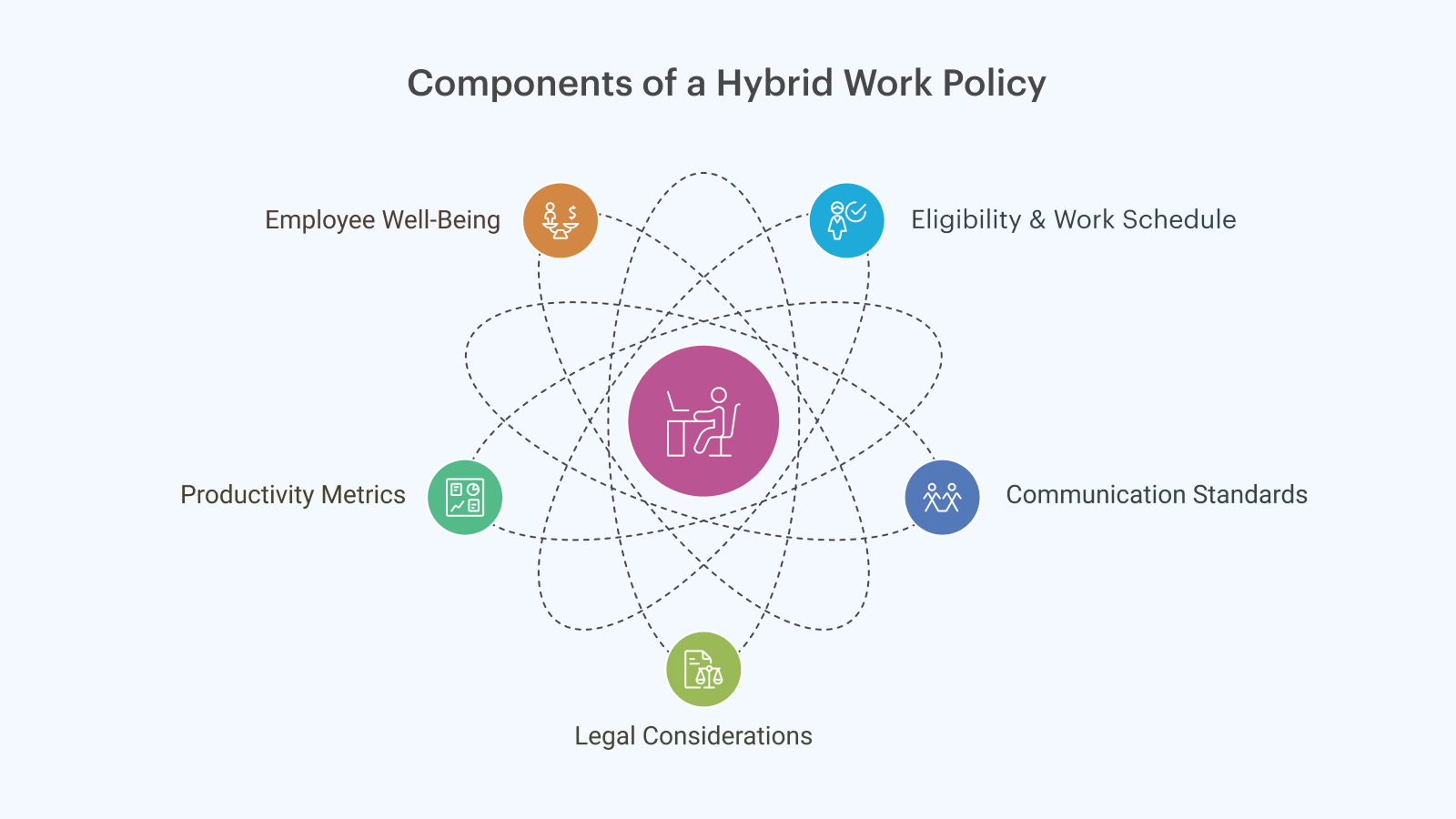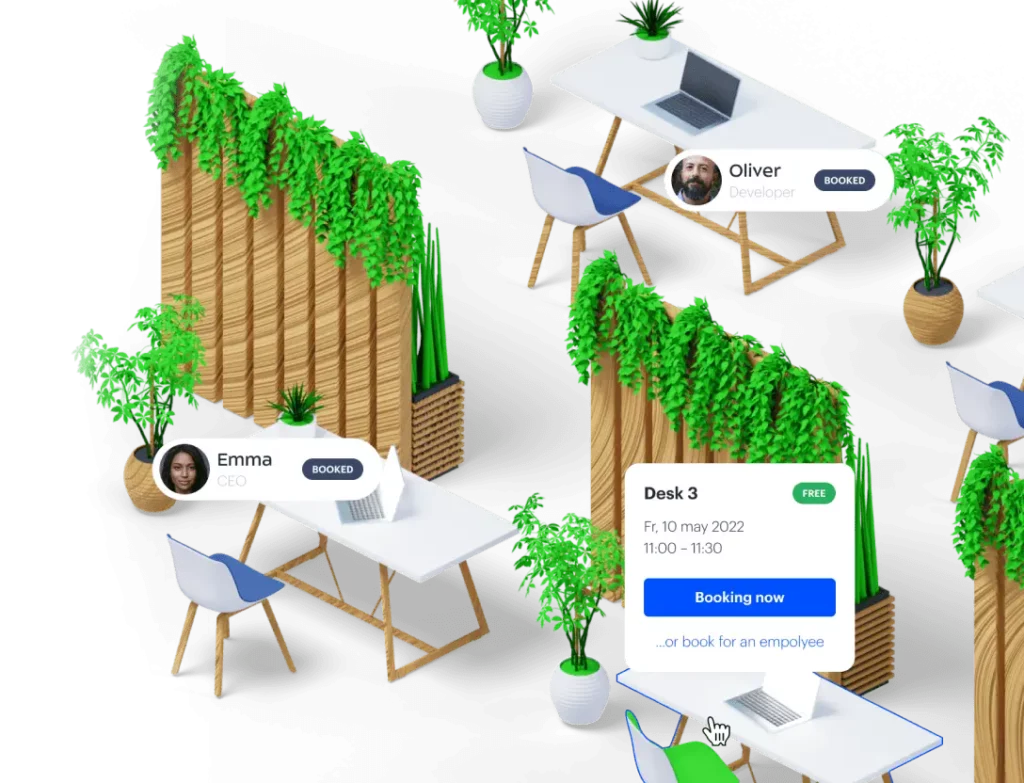Struggling to balance remote and in-office work? You’re not alone. Many organizations face confusion amid the rapid shift to hybrid work. This guide offers a clear, step-by-step approach to creating an effective hybrid work policy. Discover key components, actionable strategies, and a practical template designed to boost productivity, enhance employee satisfaction, and streamline work arrangements. Dive in to transform your hybrid work environment into a balanced and thriving ecosystem.
Key Takeaway
Organizations worldwide are embracing a hybrid work model that blends remote and in-office collaboration. This transition to hybrid work not only improves work-life balance but also enhances job satisfaction and overall productivity in today’s dynamic work environment.
⭐ Accenture’s survey shows that 83% of employees favor a hybrid model allowing at least 25% remote work, while Microsoft found that 66% of businesses are redesigning their workplaces to better support this shift.
Key benefits of robust hybrid work policies include:
- Enhanced flexibility: Empowers employees to balance personal and professional commitments.
- Improved job satisfaction: Attracts and retains top talent.
- Cost savings: Optimizes office space usage.
Clear guidelines and careful planning are essential to a successful transition, ensuring a thriving hybrid work setting.
A little theory: What is a Hybrid Work Policy? Definition & Importance
A hybrid work policy is a formal framework that outlines how employees split their time between in-office and work from home settings. It stems from a hybrid work model, which blends flexibility with structured work arrangements to create a balanced hybrid work environment.
What Is a Hybrid Work Model?
In a traditional setup, everyone works onsite. In a purely remote approach, everyone works offsite. The hybrid work model combines both, allowing teams to interact in person and also leverage the convenience of remote work.
Why It Matters
- Employee Satisfaction: A carefully designed hybrid policy can boost morale, productivity, and company culture by giving employees control over their schedules.
- Efficiency: Hybrid work arrangements encourage fewer commute hours and flexible work from home days, saving time and energy.
- Retention & Attraction: A well-structured hybrid approach helps attract top talent who value flexibility.
- Scalability: Rethinking office space usage can reduce overhead and support future growth.
By implementing a clear hybrid work policy, organizations can foster a balanced environment where employees thrive — whether they’re onsite or remote.
Key Components of a Hybrid Work Policy
The evolution of work accelerated during the pandemic, and today organizations strive to offer the best of both worlds — balancing in-office and remote work. A well-crafted hybrid work policy is built on clear guidelines, robust communication, and a strong focus on employee well-being.

Eligibility & Work Schedule Guidelines
The first step in establishing effective hybrid work policies is to identify which roles are suitable for a hybrid work arrangement. Not every position is ideal for remote work. For example, customer-facing roles or jobs requiring specialized equipment and dedicated office space might need regular in-person collaboration, while other roles can flourish with flexibility.
When assessing eligibility, consider:
- Job responsibilities: Does the role require continuous face-to-face interaction?
- Access to tools and technology: Can employees reliably work from multiple work locations?
- Performance and tenure: How do individual work habits support a flexible schedule?
Once eligibility is clear, define your hybrid work schedule. Options include:
- Fixed hybrid schedules: Predetermined days for in-office and remote work (e.g., three days onsite, two days offsite).
- Flexible hybrid schedules: Allow remote employees to choose their work schedules based on personal needs and job requirements.
For instance, a sample hybrid team schedule might look like this:
| Employee | Mo | Tu | We | Th | Fr |
| John Smith | In-office | In-office | Remote | In-office | Remote |
| Jane Doe | Remote | In-office | In-office | Remote | In-office |
| Bob Johnson | In-office | Remote | In-office | Remote | In-office |
A checklist for eligibility might include:
- Job responsibilities and duties
- Need for face-to-face interaction
- Availability of necessary tools and technology
- Consideration of individual performance and tenure
Communication & Collaboration Standards
A successful hybrid work environment depends on clear communication and seamless collaboration among all team members. Establishing consistent standards helps maintain a strong company culture. Best practices include:
- Centralized communication: Use platforms like Slack or Microsoft Teams for instant messaging and team updates.
- Regular video meetings: Schedule periodic video calls to simulate in-person collaboration and foster connection.
- Clear response expectations: Define response times that respect individual work hours and the urgency of each task.
- Collaborative tools: Encourage the use of Google Docs, Trello, or similar applications for real-time project management.
🚀 To further improve collaboration, integrate UnSpot's Hybrid Team Schedule — it lets you see when team members are in the office or working remotely. This makes it easy to schedule meetings and coordinate in real time.
Legal Considerations & Compliance in Hybrid Work
Implementing a hybrid work policy also means navigating legal and regulatory landscapes. Key points include:
- Tax and employment laws: Adjustments may be necessary if employees work from different states or countries, affecting tax obligations and employment status.
- Data security and confidentiality: With remote work, protecting sensitive data is critical. Utilize secure VPNs, multi-factor authentication, and regular security training.
- Contract updates: Revise employment contracts to reflect new work schedules and work locations, ensuring compliance with current regulations.
- Expert consultation: Engage legal and tax advisors to validate that your hybrid policies meet all local and international requirements.
💡 For example, a financial firm might update contracts and deploy robust cybersecurity measures to safely transition its workforce to a hybrid model.
Productivity & Performance Metrics in a Hybrid Workplace
Measuring productivity in a hybrid workplace requires a shift from traditional, time-based assessments to outcome-focused metrics. Key strategies include:
- Outcome-driven evaluations: Focus on deliverables and results rather than physical presence.
- Defined KPIs: Set clear, role-specific performance indicators that align with broader company goals.
- Regular check-ins: Conduct consistent performance reviews and feedback sessions tailored for a hybrid setup.
- Data-driven insights: Leverage real-time analytics to monitor in-office engagement and workspace utilization.

Different performance tracking methods can be compared as follows:
| Method | Pros | Cons |
| Task-based tracking | Emphasizes deliverables and clear outcomes | May overlook the full scope of an employee's work |
| Time tracking | Offers insight into work schedules and time usage | Risks micromanagement and may affect trust |
| Goal-based tracking | Aligns individual efforts with company objectives | Requires ongoing communication and adjustment |
| 360-degree feedback | Provides a comprehensive view of performance | Can be subjective and time-consuming |
Employee Well-Being & Hybrid Workplace Engagement
A thriving hybrid work policy goes beyond logistics — it must prioritize employee well-being to achieve a better work-life balance. Consider the following:
- Boundary setting: Encourage employees to establish clear limits between work and personal time, minimizing after-hours communication unless urgent.
- Wellness initiatives: Provide access to resources like stress management workshops, mindfulness training, and wellness stipends.
- Regular check-ins: Use one-on-one meetings and surveys to gauge job satisfaction and address any challenges.
- Social engagement: Organize virtual or in-person events to maintain strong bonds among hybrid team members and reinforce a positive company culture.
🖊️For instance, a tech startup might offer monthly wellness allowances, host virtual yoga sessions, and create informal chat groups to keep remote workers connected. Such measures not only enhance productivity but also support a resilient and engaged workforce.
Transition to Hybrid Work: Step-by-Step Implementation Guide
Successfully transitioning to a hybrid work environment means carefully planning how to implement a hybrid work policy that meets both business goals and employee needs. Here’s a concise guide:
1. Define Objectives & Understand Your Workforce
- Evaluate overall business goals and the feasibility of a hybrid model.
- Survey remote employees and in-office staff to learn their preferences.
- Align the hybrid policy with your company’s strategy.
2. Establish a Clear Hybrid Schedule
- Determine eligibility for hybrid work based on job functions and responsibilities.
- Create a detailed hybrid schedule that outlines core in-office days versus flexible remote work days.
- Communicate guidelines clearly to the entire workforce.
3. Adopt the Right Technology
- Invest in reliable video conferencing and collaboration tools.
- Ensure that all remote employees have access to necessary equipment and support.
4. Set Communication & Workflow Protocols
- Define expectations for response times and regular updates.
- Use project management tools to keep remote and in-office teams synchronized.
5. Ensure Legal Compliance & Security
- Review and update employment contracts to reflect new work arrangements.
- Implement robust data security measures and train employees accordingly.
6. Pilot and Refine the Process
- Launch a pilot program with a small group to test the new policy.
- Gather feedback, make adjustments, and then roll out the policy across your workforce.
📋 Checklist
- Conduct feasibility and employee surveys
- Define eligibility and establish a hybrid schedule
- Invest in essential technology
- Set clear communication protocols
- Ensure legal and security compliance
- Pilot, gather feedback, and refine
Common Mistakes When Implementing Hybrid Work (And How to Avoid Them)
When transitioning to hybrid work, avoiding common pitfalls is key to a smooth experience for both in-office staff and hybrid workers. Here are some mistakes and practical solutions:
Unclear Guidelines
| ❌ Vague instructions on work hours and performance expectations leave employees confused | ✅ Create a clear policy detailing eligibility, hybrid schedule rules, communication protocols, and evaluation metrics |
Inadequate Technology Investment
| ❌ Relying on personal devices or outdated tools undermines productivity | ✅ Equip all hybrid workers with up-to-date hybrid work software and necessary hardware, ensuring smooth access to company systems |
Overlooking Remote Employees
| ❌ Prioritizing those in the office can marginalize remote team members | ✅ Foster inclusivity by integrating remote workers into meetings and decision-making, and ensuring equal access to resources like office space alternatives when needed |
Complex Hybrid Schedules
| ❌ Outdated security protocols risk sensitive information | ✅ Opt for simple, flexible scheduling that allows employees to balance remote and in-office time effectively |
Neglecting Data Security
| ❌ Outdated security protocols risk sensitive information | ✅ Implement robust measures — VPNs, multi-factor authentication — and provide regular training |
Key Takeaways:
- Set clear expectations for all aspects of hybrid work.
- Invest in proper technology and tools.
- Include every team member equally.
- Keep scheduling simple and secure.
Hybrid Work Policy Template (Downloadable)
Ready to streamline your transition to a successful hybrid work environment? Our downloadable hybrid work policy template is designed to help you write a comprehensive framework that aligns with today’s best practices. This template breaks down the essentials of a robust hybrid model — covering clear guidelines for flexible work arrangements, effective communication, and performance metrics that support employee needs.
By using this tool, you can easily create a hybrid work policy that:
- Outlines precise expectations for both in-office and remote work
- Incorporates best practices to foster a collaborative workplace
- Provides actionable steps to support employees and enhance overall work output







